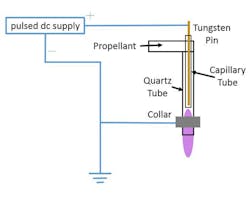WASHINGTON, DC, NOV 6, 2018 -- Many of today's methods of purifying water rely on filters and chemicals that need regular replenishing or maintenance. Millions of people, however, live in areas with limited access to such materials, leading the research community to explore new options of purifying water in using plasmas. Many plasma-based approaches are expensive, but a new class of plasma devices may change that.
Researchers at the University of Alabama in Huntsville have been studying a new type of plasma generator for water purification. The new generator pulses voltage signals to ionize gas at atmospheric pressure and produce many useful byproducts, including hydroxyl radicals, which cause a cascade of reactions that lead to purer water samples.
"We're finding ways to speed up the purification process," said Ryan Gott, a doctoral candidate in aerospace engineering at UAH who presented the research at the American Physical Society 71st Annual Gaseous Electronics Conference and the 60th Annual meeting of the APS Division of Plasma Physics, which took place Nov. 5-9 at the Oregon Convention Center in Portland.
"In theory, if this technology can be developed in a real-world, practical system, it would be able to purify water at lower costs than current methods can," Gott said.
While the term "plasma" conjures images of superhot solar jets traveling through space, most plasma-based water purification approaches work through plasma's ability to generate reactive free radicals, rendering many compounds in the water inert. The plasma and ensuing chemical reactions release energy and chemical species that can kill even tough microcystin bacteria, one culprit in algal blooms that lurk in our water supply.
"The pulses are so fast that it doesn't change the temperature of the water," Gott said. "You can touch our plasma jet with your hand."
Unlike more common, ozone-producing plasma purifiers, the new device relies on the production of hydroxyl radicals. This method will hopefully sidestep some of the hurdles that have hampered ozone-based counterparts, namely high power consumption and challenges keeping excessive heat in check.
Using optical emission spectroscopy, the UAH researchers have been able to compare how different factors play a role in producing more hydroxyl radicals from their plasma device. Increasing voltage, for example, appears to have the biggest effect on output, followed by increasing the frequency of the pulses.
Right now, the device is limited to 10 kilovolts, but the researchers are hoping to see what higher voltage could mean down the road.
Gott said after the group continues to better understand the mechanisms behind how the plasma interacts with water, he hopes to scale up the technology for point-of-use applications.
"The end goal is to develop something that can be mass-produced and distributed to places that need it the most," he said.



